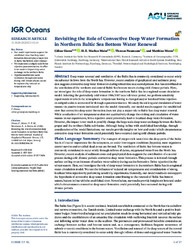Revisiting the Role of Convective Deep Water Formation in Northern Baltic Sea Bottom Water Renewal
DOI: https://doi.org/10.1029/2020JC016114
Persistent URL: http://resolver.sub.uni-goettingen.de/purl?gldocs-11858/9288
Persistent URL: http://resolver.sub.uni-goettingen.de/purl?gldocs-11858/9288
Giesse, Céline; Meier, H. E. Markus; Neumann, Thomas; Moros, Matthias, 2020: Revisiting the Role of Convective Deep Water Formation in Northern Baltic Sea Bottom Water Renewal. In: Journal of Geophysical Research: Oceans, Band 125, 10, DOI: 10.1029/2020JC016114.
 |
Dokument öffnen: |
Deep water renewal and ventilation of the Baltic Sea is commonly considered to occur solely via saltwater inflows from the North Sea. However, recent analysis of geophysical and sediment proxy data suggests convective deep water formation during wintertime as a second process that has contributed to the ventilation of the northern and central Baltic Sea bottom waters during cold climate periods. Here, we investigate the role of deep water formation in the northern Baltic Sea in a regional ocean circulation model. Selecting the particularly cold winter 1986/1987 as a reference period, we perform sensitivity experiments in which the atmospheric temperature forcing is changed and/or localized brine rejection on subgrid scales is accounted for through a parameterization. We study the sinking and circulation of water masses via passive tracers introduced into the model. Generally, our model results support the established view that convective deep water formation does not play a major role in Baltic Sea deep water renewal. While a reduction of air temperatures does not qualitatively change the sinking and circulation of water masses in our experiments, brine rejection could potentially lead to localized deep water formation. However, the impact is too weak to possibly change the large-scale deep water exchange between the Baltic proper and the northern Baltic sub-basins. Although being in line with established knowledge, through consideration of the model limitations, our results provide insights on how and under which circumstances convective deep water formation could potentially have occurred during cold climate periods.
Statistik:
ZugriffsstatistikSammlung:
- Geographie, Hydrologie [453]
This is an open access article under the terms of the Creative Commons Attribution License, which permits use, distribution and reproduction in any medium, provided the original work is properly cited.

